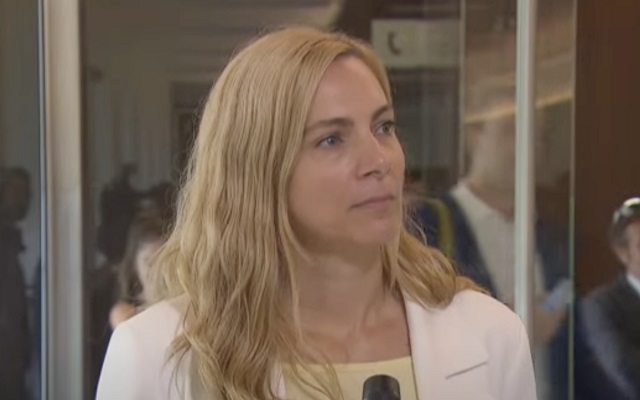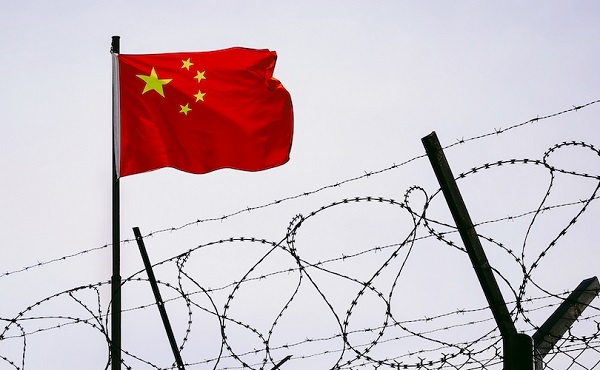Business
Trudeau gov’t dept. suggests giving LGBT, minority journalists $45k annually to promote ‘diversity’

Heritage Minister Pascale St-Onge
From LifeSiteNews
‘Organizations mentioned the need for government funds dedicated to creators and journalists from Indigenous, racialized and religious minority communities in the media’
The Canadian Department of Heritage is advising that Indigenous, Muslim, Black or LGBT identifying journalists be federally funded up to $45,000 per year to promote “diversity.”
According to a report titled Changing Narratives Fund Report On Consultations, published November 28 by Blacklock’s Reporter, the Department of Canadian Heritage has recommended that the Cabinet directly give individual reporters a salary of $45,000 annually.
“Organizations mentioned the need for government funds dedicated to creators and journalists from Indigenous, racialized and religious minority communities in the media,” said the report. “Funding should be stable and targeted.”
The proposed scheme, submitted by departmental advisors, professors Christopher Dornan and Adrian Harewood of Carleton University and Patrick White of the University of Québec, suggests “a salary of $45,000 per annum” for reporters who are Indigenous, Muslim, Black or LGBT.
“Hiring journalists and creators from diverse communities especially new talent alone cannot guarantee diverse perspectives will be presented in media coverage,” the report asserted. “If these new talents are not trained or allocated budgets or resources to share their stories they may well remain invisible.”
“For these stories to be seen a paradigm shift is needed in the way traditional news media share the stories of Indigenous, racialized and religious minority communities,” it continued.
“A number of organizations argued media coverage of the reality of their communities has not only been historically deficient but has often been detrimental,” the report alleged.
“Consequently the lack of regular and daily contact between majority and minority communities leads to misunderstanding of the other and worsens stereotypes and negative attitudes,” it added.
The report failed to explain how “diversity” of reporting could be maintained if the Liberal government under the leadership of Prime Minister Justin Trudeau is funding the journalists’ salaries.
The discriminatory proposal was not lost on Canadians, who took to social media to voice their concerns over the suggestion.
“Communism much??” one wrote on X, formerly known as Twitter.
Communism much??
— Slick Greg (@mrgregparsons) November 28, 2023
“Not even trying to hide the bribery anymore!” another posted.
Not even trying to hide the bribery anymore!
— Stephen M Lloyd 🇨🇦 🌻 (@StephenMLloyd2) November 28, 2023
“Government Approved Newsrooms are Pravda,” one wrote, referring to the official newspaper of the former Communist Party of the Soviet. “Government has no place in promoting narrative.”
Government Approved Newsrooms are Pravda … FULL STOP! Government has no place in promoting narrative.
— Sanitary Napping (@NilPointerFound) November 28, 2023
Notably, the call for increased federal funding for journalists closely follows Trudeau’s fall economic statement which includes massive payouts for mainstream media outlets ahead of and after the 2025 election.
Beginning in 2019, Parliament changed the Income Tax Act to give yearly rebates of 25 percent for each news employee in cabinet-approved media outlets earning up to $55,000 a year, to a maximum of $13,750.
However, the Canadian Heritage Department since admitted that the payouts are not sufficient to keep legacy media outlets running. The department recommended that rebates be doubled next year to a maximum $29,750 annually.
This suggestion was adopted by the Trudeau government in its Fall Economic Statement, which increased the rebates to 35 percent on newsroom salaries up to $85,000, totaling a maximum rebate of $29,750. The temporary tax credit is set to apply for the next four years.
While media subsidies were to set to expire March 31, 2024, they have now been expanded to 2029 past the next general election. The increased payouts are expected to cost taxpayer $129 million in the next five years and an additional $10 million for every subsequent year.
The renewed media bailouts come as trust in mainstream media is polling at an all-time low with Canadians.
According to a recent study by Canada’s Public Health Agency, less than a third of Canadians displayed “high trust” of the federal government, with “large media organizations” as well as celebrities getting even lower scores.
Large mainstream media outlets and “journalists” working for them scored a “high trust” rating of only 18 percent. This was followed by only 12 percent of people saying they trusted “ordinary people,” with celebrities garnering only an eight percent “trust” rating.
Business
Some Of The Wackiest Things Featured In Rand Paul’s New Report Alleging $1,639,135,969,608 In Gov’t Waste


From the Daily Caller News Foundation
Republican Kentucky Sen. Rand Paul released the latest edition of his annual “Festivus” report Tuesday detailing over $1 trillion in alleged wasteful spending in the U.S. government throughout 2025.
The newly released report found an estimated $1,639,135,969,608 total in government waste over the past year. Paul, a prominent fiscal hawk who serves as the chairman of the Senate Homeland Security and Governmental Affairs Committee, said in a statement that “no matter how much taxpayer money Washington burns through, politicians can’t help but demand more.”
“Fiscal responsibility may not be the most crowded road, but it’s one I’ve walked year after year — and this holiday season will be no different,” Paul continued. “So, before we get to the Feats of Strength, it’s time for my Airing of (Spending) Grievances.”
Dear Readers:
As a nonprofit, we are dependent on the generosity of our readers.
Please consider making a small donation of any amount here.
Thank you!
The 2025 “Festivus” report highlighted a spate of instances of wasteful spending from the federal government, including the Department of Health and Human Services (HHS) spent $1.5 million on an “innovative multilevel strategy” to reduce drug use in “Latinx” communities through celebrity influencer campaigns, and also dished out $1.9 million on a “hybrid mobile phone family intervention” aiming to reduce childhood obesity among Latino families living in Los Angeles County.
The report also mentions that HHS spent more than $40 million on influencers to promote getting vaccinated against COVID-19 for racial and ethnic minority groups.
The State Department doled out $244,252 to Stand for Peace in Islamabad to produce a television cartoon series that teaches children in Pakistan how to combat climate change and also spent $1.5 million to promote American films, television shows and video games abroad, according to the report.
The Department of Veterans Affairs (VA) spent more than $1,079,360 teaching teenage ferrets to binge drink alcohol this year, according to Paul’s report.
The report found that the National Science Foundation (NSF) shelled out $497,200 on a “Video Game Challenge” for kids. The NSF and other federal agencies also paid $14,643,280 to make monkeys play a video game in the style of the “Price Is Right,” the report states.
Paul’s 2024 “Festivus” report similarly featured several instances of wasteful federal government spending, such as a Las Vegas pickleball complex and a cabaret show on ice.
The Trump administration has been attempting to uproot wasteful government spending and reduce the federal workforce this year. The administration’s cuts have shrunk the federal workforce to the smallest level in more than a decade, according to recent economic data.
Festivus is a humorous holiday observed annually on Dec. 23, dating back to a popular 1997 episode of the sitcom “Seinfeld.” Observance of the holiday notably includes an “airing of grievances,” per the “Seinfeld” episode of its origin.
Alberta
A Christmas wish list for health-care reform

From the Fraser Institute
By Nadeem Esmail and Mackenzie Moir
It’s an exciting time in Canadian health-care policy. But even the slew of new reforms in Alberta only go part of the way to using all the policy tools employed by high performing universal health-care systems.
For 2026, for the sake of Canadian patients, let’s hope Alberta stays the path on changes to how hospitals are paid and allowing some private purchases of health care, and that other provinces start to catch up.
While Alberta’s new reforms were welcome news this year, it’s clear Canada’s health-care system continued to struggle. Canadians were reminded by our annual comparison of health care systems that they pay for one of the developed world’s most expensive universal health-care systems, yet have some of the fewest physicians and hospital beds, while waiting in some of the longest queues.
And speaking of queues, wait times across Canada for non-emergency care reached the second-highest level ever measured at 28.6 weeks from general practitioner referral to actual treatment. That’s more than triple the wait of the early 1990s despite decades of government promises and spending commitments. Other work found that at least 23,746 patients died while waiting for care, and nearly 1.3 million Canadians left our overcrowded emergency rooms without being treated.
At least one province has shown a genuine willingness to do something about these problems.
The Smith government in Alberta announced early in the year that it would move towards paying hospitals per-patient treated as opposed to a fixed annual budget, a policy approach that Quebec has been working on for years. Albertans will also soon be able purchase, at least in a limited way, some diagnostic and surgical services for themselves, which is again already possible in Quebec. Alberta has also gone a step further by allowing physicians to work in both public and private settings.
While controversial in Canada, these approaches simply mirror what is being done in all of the developed world’s top-performing universal health-care systems. Australia, the Netherlands, Germany and Switzerland all pay their hospitals per patient treated, and allow patients the opportunity to purchase care privately if they wish. They all also have better and faster universally accessible health care than Canada’s provinces provide, while spending a little more (Switzerland) or less (Australia, Germany, the Netherlands) than we do.
While these reforms are clearly a step in the right direction, there’s more to be done.
Even if we include Alberta’s reforms, these countries still do some very important things differently.
Critically, all of these countries expect patients to pay a small amount for their universally accessible services. The reasoning is straightforward: we all spend our own money more carefully than we spend someone else’s, and patients will make more informed decisions about when and where it’s best to access the health-care system when they have to pay a little out of pocket.
The evidence around this policy is clear—with appropriate safeguards to protect the very ill and exemptions for lower-income and other vulnerable populations, the demand for outpatient healthcare services falls, reducing delays and freeing up resources for others.
Charging patients even small amounts for care would of course violate the Canada Health Act, but it would also emulate the approach of 100 per cent of the developed world’s top-performing health-care systems. In this case, violating outdated federal policy means better universal health care for Canadians.
These top-performing countries also see the private sector and innovative entrepreneurs as partners in delivering universal health care. A relationship that is far different from the limited individual contracts some provinces have with private clinics and surgical centres to provide care in Canada. In these other countries, even full-service hospitals are operated by private providers. Importantly, partnering with innovative private providers, even hospitals, to deliver universal health care does not violate the Canada Health Act.
So, while Alberta has made strides this past year moving towards the well-established higher performance policy approach followed elsewhere, the Smith government remains at least a couple steps short of truly adopting a more Australian or European approach for health care. And other provinces have yet to even get to where Alberta will soon be.
Let’s hope in 2026 that Alberta keeps moving towards a truly world class universal health-care experience for patients, and that the other provinces catch up.
-

 International2 days ago
International2 days agoGeorgia county admits illegally certifying 315k ballots in 2020 presidential election
-

 International2 days ago
International2 days agoCommunist China arrests hundreds of Christians just days before Christmas
-

 Energy23 hours ago
Energy23 hours agoThe Top News Stories That Shaped Canadian Energy in 2025 and Will Continue to Shape Canadian Energy in 2026
-

 Business1 day ago
Business1 day agoSome Of The Wackiest Things Featured In Rand Paul’s New Report Alleging $1,639,135,969,608 In Gov’t Waste
-

 Alberta2 days ago
Alberta2 days agoCalgary’s new city council votes to ban foreign flags at government buildings
-

 Business2 days ago
Business2 days agoWarning Canada: China’s Economic Miracle Was Built on Mass Displacement
-

 International22 hours ago
International22 hours ago$2.6 million raised for man who wrestled shotgun from Bondi Beach terrorist
-

 Alberta2 days ago
Alberta2 days agoWhat are the odds of a pipeline through the American Pacific Northwest



